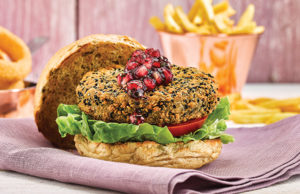Some things always sell well when the sun shines, but this year, customers are looking for individualised offerings, Helena Drakakis discovers.
Summer is almost here. Lighter nights, warmer weather and the holiday season are edging closer. But, for retailers and foodservice outlets, managing the season takes detailed planning way beyond wondering whether the sun will shine. Balancing regular summer occasions with sporadic events, unpredictable weather and a fluctuation in tourism means that it’s a crucial time for wholesalers to tap into the wants, needs and desires of their customers.
“The summer season is massive,” says Tom Gittins, business development manager at buying group Confex. “A lot of profits come from this time of year. It’s determined by the weather and big events, but with more outdoor events going on, there’s enough to get people out, which is when they need food and drink.”
Wholesalers that tap into trends and understand how to make the most of summer – whether it’s in food-to-go, dining out, soft drinks, or wines and spirits – will reap the rewards. In this tips-packed cover story, we look at this summer’s superstar categories and feature the latest advice for wholesalers looking to heat up summer sales.
Understand your customers’ needs
According to foodservice wholesaler Bidfood, understanding the needs of your customer is paramount to succeeding in the summer season. Whether your customer is a village pub or a five-star hotel, it’s important to have a clear idea of how each outlet uses ingredients and to respond by offering core products that can be used flexibly.
 “We understand what basic summer fare looks like, but we try to assist caterers to create their own summer,” says Bidfood’s commercial director Andrew Roberts. “They might want a basic burger, but we’ll offer a blue cheese topping or an urban spice to rub into it, so caterers can personalise each dish.”
“We understand what basic summer fare looks like, but we try to assist caterers to create their own summer,” says Bidfood’s commercial director Andrew Roberts. “They might want a basic burger, but we’ll offer a blue cheese topping or an urban spice to rub into it, so caterers can personalise each dish.”
Items such as bacon can be used in breakfast, lunchtime salads or an evening carbonara, depending on optimum time-of-day sales. “It’s about keeping things simple but innovative,” Roberts adds.
For north of England wholesaler Parfetts, understanding the needs of customers has been central to the company’s recent restructure. According to Guy Swindell, the company’s head of customer development and marketing, Parfetts now runs four seasonal trade weeks throughout the year, with one geared specifically towards summer. Deep-cut promotions are offered and suppliers are encouraged to attend.
“Suppliers will bring along new products, and there will be tastings and category-specific advice. For our retail club members, there’s a chance to build relationships, often with a supplier following on with a visit to the store,” Swindell says.
Conversely, suppliers are often keen for wholesalers to visit manufacturing sites to understand how the company operates. One firm that offers this is Yorkshire-based salad manufacturer Troy Foods. It invites wholesalers into its facilities to view its processes and procedures, so that they gain a strong understanding of the company.
“This understanding helps establish a smoother ordering process, and gives them an appreciation of everything our products have to go through in terms of stringent quality and excellence checks,” says Troy Foods’ commercial manager James Kempley.
However, with wholesalers experiencing significant uplift in demand if the weather is excellent, suppliers in turn have to respond quickly. “We do our best to accommodate customers by delivering their chosen product on time, and we also ensure that we manage expectations,” he adds.
Plan with your customers
During the summer, wholesalers tend to focus on key lines such as fresh, soft drinks, water, frozen and certain non-food items. Working with customers and suppliers to identify bestselling items is paramount in achieving more accurate forecasting. Under-forecasting can spark availability problems, while over-forecasting can result in cash flow being tied up in the wrong products.
So, how do wholesalers get it right? Landmark member Hyperama Wholesale not only analyses historical data patterns and promotions during key seasonal times, but regularly shares information and market data with important suppliers. “Regular meetings and updates also assist in more accurate predictions of stock levels,” says managing director Aris Poulis.
But, relying on data alone doesn’t provide the whole picture, as many variables apply during the summer, not least the weather.
At Bidfood, the company’s automated system means stock levels across all its depots can be accessed at any given time and judged relative to sales and manufacturers’ lead times.
Back-up is also in place for freak shortages. “No matter how much planning you do, something can always go wrong,” Roberts says, adding that all of Bidfood’s most important lines are linked to a suitable alternative product. “If ‘A’ is unavailable, we automatically send ‘B’ because we know it’s a close substitute,” he says.
According to Hyperama’s Poulis, effective communication is as important as availability. “Communication of events and promotions is key, so we have a detailed marketing plan in place with every supplier,” he says, adding that this involves, among other methods, leaflets, depot displays, sampling and vouchers.
“Customers need to be well informed, but they also need to be aware that when they visit the depot, the return on their investment is optimised.”
Tap into holiday trends
The ‘staycation’ is here to stay and tourist information centres are already reporting record numbers of bookings ahead of this British summer. But it’s not just holiday-makers that wholesalers need to keep an eye on. More outdoor events mean that keeping abreast of festivals, local fetes and fun days that many families attend on a whim are as important as tapping into national events like major sporting tournaments.
 Confex’s Gittins believes there are many events that people attend on the spur of the moment, depending on the weather. This provides his members, 95% of which are delivered wholesalers, with a great opportunity to supply food and drink. “There isn’t a World Cup or an Olympics this year, but there’s enough to get people out and about regardless,” he says.
Confex’s Gittins believes there are many events that people attend on the spur of the moment, depending on the weather. This provides his members, 95% of which are delivered wholesalers, with a great opportunity to supply food and drink. “There isn’t a World Cup or an Olympics this year, but there’s enough to get people out and about regardless,” he says.
In the absence of sporting events, Bidfood also turns its attention to family holidays and family days out, creating a point of difference in its offerings. “There are the usual summer superstars such as water and ice cream, but to differentiate ourselves we tap into certain trends,” explains Roberts. “Currently, there’s a trend around Americana, so we are offering an exclusive range of ice creams that lean up against that concept.”
Be prepared for changing conditions
According to Confex’s Gittins, a sunny weekend has the power to double sales while a rainy weekend can do the opposite. So, suppliers and wholesalers must be armed with insight and have the agility to respond to changing conditions.
Nestlé Waters UK says 26°C is the sweet spot where a significant sales spike in bottled water can be seen. Therefore, wholesalers should think about positioning important lines nearer to till areas to help retailers top up quickly. Tying bottled water sales with fresh food, confectionery and snacking options may also increase secondary site sales, although chocolate sales can slump once it’s hotter than 25°C.
Scottish retailer Ferhan Ashiq, who runs two stores in Musselburgh, says he would like to see more, smaller case sizes on key items as a way of better managing cash flow and avoiding leftover stock.
“It’s difficult to manage stock when the weather is unpredictable,” he says. “One week we’re selling out so we increase our order, the next week we’re packing the shelves because it’s rained. I’m tied to minimum orders, otherwise I get penalised. I’d like to be able to order smaller cases at certain times.”
It also pays to keep in touch with suppliers who are tuned into long-range weather forecasts. Confex’s Gittins adds: “We communicate weather predictions to our members through social media and our newsletter. We’ve found that soft-drinks suppliers are really good at telling customers when to stock up and when peak periods might be. We also have last-minute social media updates telling customers when their last ordering times are before a predicted surge.”
Up your game on food-to-go
Food-to-go, whether it’s takeaway meals or on-the-hoof snacking, is a major growth area. Troy Foods has seen its own-brand salad range grow by 50% over the past year, bringing it to a value of £5m. However, when food is perishable, it pays to be aware of manufacturers’ lead times.
Troy Foods’ Kempley says: “We make orders fresh. This gives the best taste and helps us to grow the brand in terms of repeat orders. We don’t hold anything more than a day’s worth of product in stock due to its perishable nature, which is why we have lead order times.”
Premium snacking options are also increasingly popular. Glasgow-based wholesaler Lomond offers café and coffee shop operators advice on presentation to help entice customers in to pick up a sandwich or a snack.
“We came up with a range of sandwiches and food-to-go options. We make them, photograph them, pull together nutritional and allergen information, and put together step-by-step assembly guides,” says procurement director Paul Lancaster. “It’s a way of allowing our customers to imagine what their food-to-go offering could look like.”
Retailers are also adding their own twists on traditional takeouts to create a point of difference. Scottish retailer Ashiq says: “I’m always thinking of how to up my game. I do slush puppies, but I’m going to offer an adults’ version with a shot of vodka – I’ll charge a premium for that. I’m also thinking about milkshakes, so I’ve got a blender coming in.”
Don’t forget the drinks
The drinks market comes into its own during summer, with sales spikes in favourite carbonates, an evolving adult soft-drinks category and a ‘healthier’ drinks market, too.
 Certain alcoholic drinks also see sales uplifts, alongside mixers, which help to fuel the thriving summer cocktail trend.
Certain alcoholic drinks also see sales uplifts, alongside mixers, which help to fuel the thriving summer cocktail trend.
According to Trystan Farnworth, commercial director for convenience and impulse at Britvic, 29% of Brits are now consuming immediately on purchase and this presents significant sales opportunities for wholesalers in the summer months.
“The increasing consumer appetite for immediate refreshment should encourage savvy wholesalers to re-evaluate the premium chiller space and adapt their ranges according to the specific needs of their customer base,” he says.
In alcoholic drinks, Heineken category and shopper marketing director Toby Lancaster highlights cider and lager as key summer players. He says: “Occasions such as hosting friends for dinner or BBQs, festivals and outdoor parties represent the key reason behind most purchases.”
However, in the past few years, Prosecco sales have been unprecedented, with no signs of a slowdown, according to Treasury Wine Estates’ senior PR manager Adam Withrington. He advises wholesalers to increase the focus on sparkling wine.
“You must make sure you stock these wines in your depot and educate retailers about the opportunities that exist for them with these wines,” he says, adding that fruit wines have also seen a 49% growth in convenience and impulse.
Lastly, hot drinks perform strongly all-year-round, with coffee a major summer player, served hot or iced.
Confex’s Gittins says: “People may have traditionally gone to the pub to meet friends, but now they go to the coffee shop all year round. Wholesalers need to keep abreast of suppliers’ promotional plans that reflect this.”








